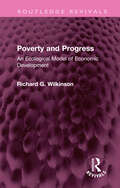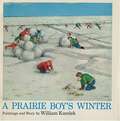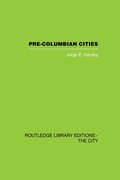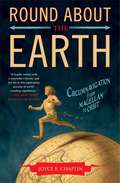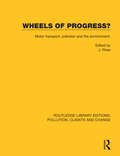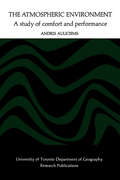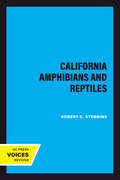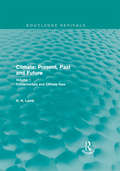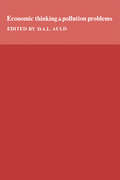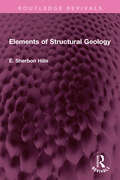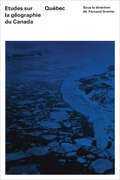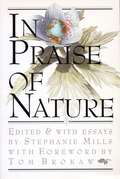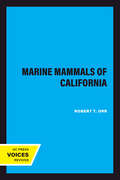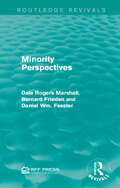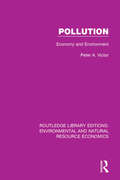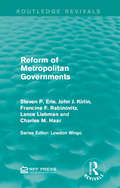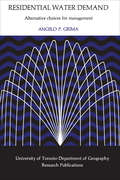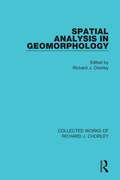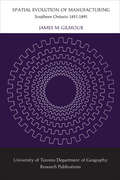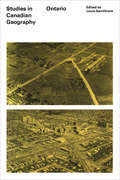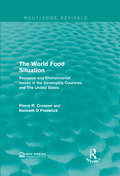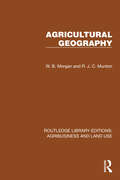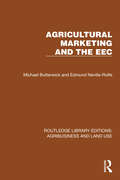- Table View
- List View
Poverty and Progress: An Ecological Model of Economic Development (Routledge Revivals)
by Richard G. WilkinsonOriginally published in 1973 and now reissued with a new Preface, this striking book challenges the whole structure of our thinking on how societies develop – why some are primitive and others advanced. It demonstrates that the pursuit of progress is not the real driving force behind change. Economic development, it argues, is simply the escape route of societies caught in the ecological pincers of population growth and scarce resources. The author explains the processes by which industrialization is forced upon societies by the progressive scarcity of all land-based resources. The things we think of as the fruits of man's search for progress including increasingly sophisticated technology, labour-saving machinery and the rest - are in fact part of the struggle to keep up with the growing productive task created by ecological pressures. ln this light primitive societies appear less poor than we imagine, and advanced ones less rich.
A Prairie Boy's Winter
by William KurelekText and twenty color paintings depict the rigors and simple pleasures during the stark 1930s.
Pre-Colombian Cities (Routledge Library Editions - The City)
by Jorge Enrique HardoyWhat visitor to Mexico City, unaware of its pre-Hispanic history, could imagine that right under a Christian Church may still lie the remains of the sinister tzompantli, the Aztecs' altar of skulls? Professor Jorge Hardoy poses this question and many more in his comprehensive summary of the ancient cities where Latin America's peoples lived before the Spaniards arrived in the sixteenth century. Because Aztec Tenochtitlan, today Mexico City, and Inca Cuzco represent the culmination of the two most advanced civilizations encountered by the Spainsh conquistadors, the author explores these cities end-to-end. He also studies such older civic memorial centers as Teotichuacan, Tula, Monte Alban, Uxmal, Chichen Itza, Tikal, Palenque, Tiahuanaco, Chan Chan, Pachacamac, Machu Picchu, and lesser know sites, most virtually, if not totally, abandoned centuries before the Conquest. Such inclusive coverage makes for a lively discussion of some fifteen hundred years of urban life as immortalized in the architecture, art, and crafts of long vanished civilizations. There is an extensive bibliography, many photographs, maps, charts and city plans showing urban layouts of temples, which tell much about the life of the inhabitants. His book shows that while new findings come to light each year, so much buried history lies waiting to be found that archaology will always be an ever unfolding drama. This book was first published in 1973.
Round About the Earth
by Joyce E. ChaplinIn this first full history of around-the-world travel, Joyce E. Chaplin brilliantly tells the story of circumnavigation. Round About the Earth is a witty, erudite, and colorful account of the outrageous ambitions that have inspired men and women to circle the entire planet. For almost five hundred years, human beings have been finding ways to circle the Earth--by sail, steam, or liquid fuel; by cycling, driving, flying, going into orbit, even by using their own bodily power. The story begins with the first centuries of circumnavigation, when few survived the attempt: in 1519, Ferdinand Magellan left Spain with five ships and 270 men, but only one ship and thirty-five men returned, not including Magellan, who died in the Philippines. Starting with these dangerous voyages, Joyce Chaplin takes us on a trip of our own as we travel with Francis Drake, William Dampier, Louis-Antoine de Bougainville, and James Cook. Eventually sea travel grew much safer and passengers came on board. The most famous was Charles Darwin, but some intrepid women became circumnavigators too--a Lady Brassey, for example. Circumnavigation became a fad, as captured in Jules Verne's classic novel, Around the World in Eighty Days. Once continental railroads were built, circumnavigators could traverse sea and land. Newspapers sponsored racing contests, and people sought ways to distinguish themselves--by bicycling around the world, for instance, or by sailing solo. Steamships turned round-the-world travel into a luxurious experience, as with the tours of Thomas Cook & Son. Famous authors wrote up their adventures, including Mark Twain and Jack London and Elizabeth Jane Cochrane (better known as Nellie Bly). Finally humans took to the skies to circle the globe in airplanes. Not much later, Sputnik, Gagarin, and Glenn pioneered a new kind of circumnavigation-- in orbit. Through it all, the desire to take on the planet has tested the courage and capacity of the bold men and women who took up the challenge. Their exploits show us why we think of the Earth as home. Round About the Earth is itself a thrilling adventure.
Wheels of Progress?: Motor transport, pollution and the environment.
by J. RoseOriginally published in 1973 and based on papers published in The International Journal of Environmental Studies, this book discusses the impact of road vehicles on the environment. Particular stress is laid on the design of towns and vehicles, economic problems associated with these, the responsibility of planners and the integration of transport planning and environmental planning at local, regional and national levels. Subsequent sections cover the science of accident research and legislation, particularly dealing with global pollution control. Many of the problems discussed remain as pressing today as when this book was first published.
Wind Is to Feel
by Shirley Cook HatchWIND IS TO FEEL has many observations about the wind, and suggestions for activities that boys and girls an do on their own or with a parent or teacher.
The Atmospheric Environment: A Study of Comfort and Performance
by Andris AuliciemsIn this study energy-exchange processes and climatic influences are examined in relation to thermal comfort and work efficiency as exemplified in a schoolroom situation. The investigation tests fundamental hypotheses on meterotropisms and optimal thermal environments and demonstrates how daily variations within atmospheric environments are considerably more important than had been previously suspected. It also describes the experimental use of a variety of microclimatic instruments and thermal indices in conjunction with psychological tests of continuous mental performance. The Atmospheric Environment treats a complex problem from a broad multi-disciplinary standpoint and is of particular interest to climatologists, psychologists, teachers and educational administrators, heating and ventilating engineers, and to all concerned with environmental management.(Department of Geography Research Publications 8).
California Amphibians and Reptiles: Revised Edition (California Natural History Guides #31)
by Robert C. StebbinsThis title is part of UC Press's Voices Revived program, which commemorates University of California Press’s mission to seek out and cultivate the brightest minds and give them voice, reach, and impact. Drawing on a backlist dating to 1893, Voices Revived makes high-quality, peer-reviewed scholarship accessible once again using print-on-demand technology. This title was originally published in 1972.This title is part of UC Press's Voices Revived program, which commemorates University of California Press’s mission to seek out and cultivate the brightest minds and give them voice, reach, and impact. Drawing on a backlist dating to 1893, Voices Revived</DIV
Climate: Volume 1: Fundamentals and Climate Now (Routledge Revivals: A History of Climate Changes)
by H. H. LambFirst published in 1972, this first volume of Professor Lamb’s study of our changing climate deals with the fundamentals of climate and climatology, as well as providing global data on the contemporary climates of the twentieth century.
Economic Thinking and Pollution Problems
by Douglas AuldThe purpose of this collection is to provide the student with an introduction to the way in which the discipline of economics tackles the problems posed in affluent societies by their various 'waste' products. 'Pollution economics' introduces a student to aspects of price economics, public finance, and political economy in relation to a pressing and complex public concern. The work includes a number of Canadian statements on pollution and its control in this country, and gives the text of two recent pieces of legislation on the topic. The selections in this volume present a wide variety of opinions, ideas, and facts about the economic dimension of the ecological crisis. Pollution costs money--pollution abatement also costs money and these costs will have to be paid somehow by some people. The contributors--politicians, businessmen, and professors--explore the problem of pollution and its control as each sees it, and the volume as a whole should help encourage a greater awareness both of economics as a way of thinking and of the difficulties in making the right public policies.
Elements of Structural Geology (Routledge Revivals)
by E. Sherbon HillsOriginally published in 1963, this classic textbook was revised fully for the 1972 edition. The author presents a comprehensive account of all topics falling within the domain of structural geology in his characteristically objective, scientific and logical manner. The book pays particular attention to definitions and the origin of terms. Geology is a global science and this book used examples and ideas from work in many countries. The book is comprehensive in scope, dealing not only with secondary structures and tectonics, but also with primary structures of secondary and igneous rocks. This was the first textbook to deal with rock material as two-phase systems rather than as solids and this approach is continued in this reissued edition by analysis of concepts such as ocean-floor spreading and plate tectonics
Etudes sur la Geographie du Canada
by Fernand GrenierThe publication of the series, 'Studies in Canadian Geography,' by the organizers of the 22nd International Geographical Congress, introduces to the international community of geographers a new perspective of the regional entities which form this vast countries. These studies should contribute to a better understanding among scholars, students, and the people of Canada of the geography of their land. Geographical works embracing the whole of Canada, few in number until recently, have become more numerous during the last few years. This series is original in its purpose of re-evaluating the regional geography of Canada. In the hope of discovering the dynamic trends and the processes responsible for them, the editors and authors of these volumes have sought to interpret the main characteristics and unique attributes of the various regions, rather than follow a strictly inventorial approach. In preparing this volume on Quebec, the contributors have looked at the evolution and present patterns of the ecumene of southern Québec, rural and urban Québec, and the dynamic biogeography of Québec.
In Praise of Nature
by Tom Brokaw Stephanie Mills Jeanne CarstensenFive thought-provoking essays by Stephanie Mills are followed by reviews and excerpts of the ten most important pieces of related literature written by experts in the various fields. Reviewers include Peter Borrelli, David Brower, Ernest Callenbach, J. Baird Callicott, Lois Gibbs, and others. Following the essays is an annotated bibliography listing over 100 important environmental works.
Marine Mammals of California (California Natural History Guides #29)
by Robert T. OrrThis title is part of UC Press's Voices Revived program, which commemorates University of California Press’s mission to seek out and cultivate the brightest minds and give them voice, reach, and impact. Drawing on a backlist dating to 1893, Voices Revived makes high-quality, peer-reviewed scholarship accessible once again using print-on-demand technology. This title was originally published in 1972.This title is part of UC Press's Voices Revived program, which commemorates University of California Press’s mission to seek out and cultivate the brightest minds and give them voice, reach, and impact. Drawing on a backlist dating to 1893, Voices Revived</DIV
Minority Perspectives (Routledge Revivals)
by Dale Rogers Marshall Bernard Frieden Daniel Wm. FesslerOriginally published in 1972, Minority Perspectives is the second in a series exploring metropolitan problems within the government structure. The 1960’s were a period of civils rights movements as well as poverty in the United States and in the 70’s, it became clear that poverty was closely linked to race. This report sets out to explore issues contributing to the metropolitan-minority poverty problem such as racial exclusion and public policy. The papers included in this report discuss issues such as political power in metropolitan areas, the impact an address can have on economic opportunity for minority groups and the effects that laws and litigation can have on poverty. This title will be of interest to students of environmental and urban studies.
Pollution: Economy and Environment (Routledge Library Editions: Environmental and Natural Resource Economics)
by Peter A. VictorThis study, originally published in 1972, examines the connections between human society and the rest of the universe that are attributable to economic activity. These include the inputs from the environment to industry, such as oxygen, used in the combustion of mineral fuels. Also included are the industrial outputs which are fed back into the environment in the form of waste products. An attempt will be made to establish functional relations between the extent and character of economic activity and the flow of materials in both directions between the economy and the environment. This title will be of interest to students of environmental and natural resource economics.
Reform of Metropolitan Governments (Routledge Revivals)
by Steven P. Erie Charles M. Haar John J. Kirlin Francine F. Rabinovitz Lance LiebmanOriginally published in 1972, this study aims to explore governmental interaction with people and publics interests and institutions in Metropolitan America. These papers discuss issues of how governance can be improved and the federal role in Metropolitanism as well as suggesting ways in which political reform can help. This title will be of interest to students of Environmental Economics and professionals.
Residential Water Demand: Alternative Choices for Management
by Angelo P. GrimaThis detailed study of the use of water at different price levels by residential consumers in the Toronto-centred region from Hamilton to Oshawa challenges the basis of our present urban water supply policy. Adoption of the recommendations presented would mean higher prices to householders, but a considerable saving of hundreds of millions of tax dollars over the next three decades. The present policy uses a 'requirement approach' in which future water needs are calculated by extrapolation of past trends and an assumption that demand is inelastic. This leads to excessive levels of water use and over-investment in water supply, sewage collection, and treatment systems. The resultant misallocation of resources can be corrected by adoption of a demand/management approach in which investment policy is guided by consumer demand and alternative pricing arrangements are used as a management tool. Dr. Grima examines several alternative choices for management, such as metering, increasing marginal prices, sewerage charges, seasonal charges, and an increasing price block schedule, and describes the results of each. Water managers in Canada are strongly challenged to begin a fundamental rethinking of their basic policies. (Department of Geography Research Publication 7)
Spatial Analysis in Geomorphology (Collected Works of Richard J. Chorley)
by Richard J. ChorleyOriginally published in 1972. This book covers from ‘linear’ statistical methods, regression and variance analysis to multivariate methods to wider spatial analytic techniques, in which a clear association is maintained between quantitative data and the spatial coordinates which locate them. The purpose of this volume is to highlight this coherent area of scholarship under the general headings of spatial point systems, networks, continuous distributions, partitioning and simulation. Seventeen authors from Britain and the United States have been brought together to produce a book whose attention is on the body of spatial techniques necessary to enable the building of dynamic spatial models of landforms which formed the keystone of much geomorphic work in future years.
Spatial Evolution of Manufacturing: Southern Ontario 1851-1891
by James M. GilmourEuropeans who settled previously unpopulated and unexploited regions of the world during the 18th and 19th centuries of the world had two economic alternatives: subsistence activities or the production of primary goods for export. In general the latter prevailed and the landscape and economy were transformed. This study examines industrial growth in Southern Ontario, one of the most economically successful regions, from 1851-1891, a period when primary activities were still very important but also when today's industrial structure was clearly being shaped. Economists, geographers, and those in related fields will welcome this approach which unites regional economic growth theory, and an empirical examination of distributional and structural change in manufacturing, in a general explanation of the spatial development of manufacturing that is relevant to all export-based regions.
Studies in Canadian Geography: Ontario
by R. Louis GentilcoreOntario is the most populous and most prosperous province in Canada. One-third of the nation's population lives here. They produce more than one-half of Canada's manufactured goods, one-quarter of her output from mines and forests, and one-third of the farm income. Accompanying this economic pre-eminence is a majestic primeval geography. Ontario extends through sixteen degrees of latitude and a distance of over 1600 kilometres from barren tundra along a saltwater shoreline in the north to fertile lowlands bordering freshwater lakes in the south. Productivity and size, two of the basic elements in the geography of the province, stand in contradiction to one another. The former is concentrated in a very small area with an identity and even a name of its own, 'Southern Ontario,' a portion of the province that is as overwhelming in its concentration of activity as the remainder is in its areal extent. The recognition of this distinction is a prerequisite to the further study of a subject which has been widely neglected, both in Ontario and in the rest of Canada. Writers and artists, historians and geographers have paid little attention to the province. It is a baffling region, one which 'has achieved a significant place in the Canadian sun, but no one quite knows what the place is, even though other areas would like to achieve the same position' (Warkentin 1966). The purpose of this short volume is to contribute to an understanding of Ontario, to point out something of what it is both to those who are already acquainted with the province and to those who are being introduced to it for the first time.
Voyages and Discoveries: Northeastern Europe, And Adjacent Countries
by Richard HakluytRenaissance diplomat and part-time spy, William Hakluyt was also England's first serious geographer, gathering together a wealth of accounts about the wide-ranging travels and discoveries of the sixteenth-century English. One of the epics of this great period of expansion, The Principal Navigations, Voyages, Traffiques and Discoveries of the English Nation describes, in the words of the explorers themselves, an astonishing era in which the English grew rapidly aware of the sheer size and strangeness of their world. Mingling accounts of the journeys of renowned adventurers such as Drake and Frobisher with descriptions by other explorers and traders to reveal a nation beginning to dominate the seas, Hakluyt's great work was originally intended principally to assist navigation and trade. It also presents one of the first and greatest modern portraits of the globe.
The World Food Situation: Resource and Environmental Issues in the Developing Countries and The United States (Routledge Revivals)
by Pierre R. Crosson Kenneth D FrederickAt the beginning of the 1970’s, global grain reserves were level and food prices were low however as the decade progressed crop production plummeted leading to a food crisis. Originally published in the aftermath in 1977, Crosson and Frederick set out to explore the ability of agricultural output to meet the global food demands of future generations. This study analyses how resources and environmental factors would affect food production in developing countries and the United States until the end of the 21st Century. The environmental impacts of land levels, fertiliser and pesticide use are explored in relation to the challenges of meeting food demands. This title will be of interest to students of environmental studies.
Agricultural Geography (Routledge Library Editions: Agribusiness and Land Use #19)
by W. B. Morgan R. J. MuntonOriginally published in 1971, this book is a systematic study of the major features and factors of the location and distribution of global agricultural enterprises. Special emphasis is given to approaches to the subject developed by economists and economic geographers, but all aspects of agricultural geography are reviewed including physical environmental problems. An introduction to the problem of classification and data collection together with instruction in some simple analytical techniques is given to equip the student with the basic methods for their own research.
Agricultural Marketing and the EEC (Routledge Library Editions: Agribusiness and Land Use #1)
by Michael Butterwick Edmund Neville-RolfeOriginally published in 1971, this book resulted from a 2-year study of the implications of the Common Market agricultural policy in relation to agricultural marketing in Britain. It provides the background to agricultural policies and explains why marketing developed differently in Britain and European countries. There are specific chapters on cereals, sugar, diary produce, horticultural products, livestock and meat, vegetable oils and oilseeds, eggs and poultry-meat and other farm products such as hops potatoes and wool). The book discusses such issues as the possible effects on British agricultural and horticultural marketing of adopting the CAP and the role played by the producer organisations.
